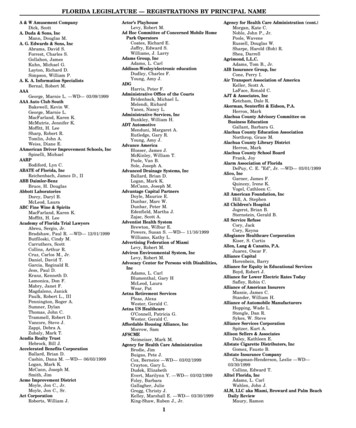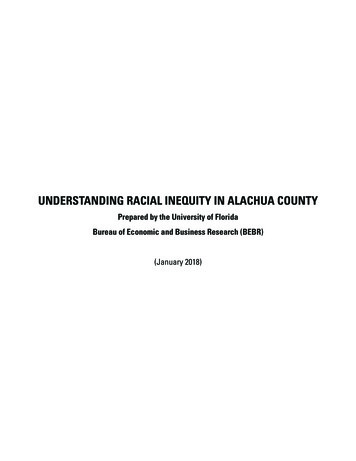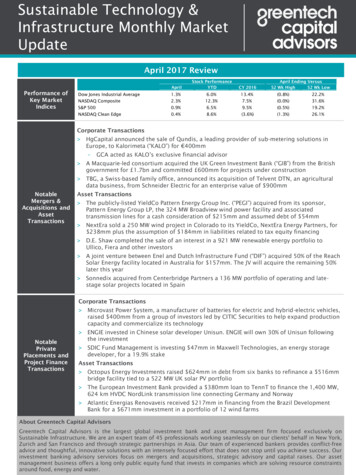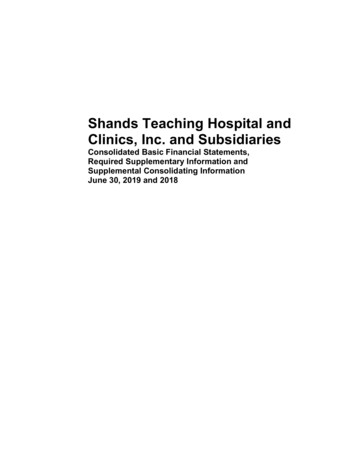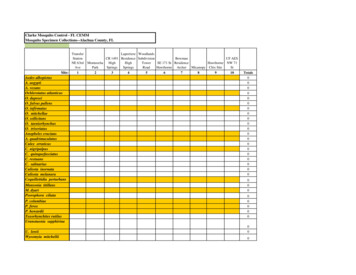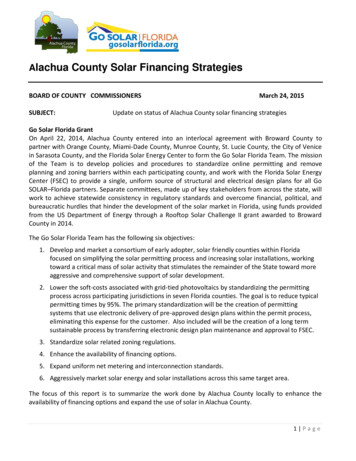
Transcription
Alachua County Solar Financing StrategiesBOARD OF COUNTY COMMISSIONERSSUBJECT:March 24, 2015Update on status of Alachua County solar financing strategiesGo Solar Florida GrantOn April 22, 2014, Alachua County entered into an interlocal agreement with Broward County topartner with Orange County, Miami-Dade County, Munroe County, St. Lucie County, the City of Venicein Sarasota County, and the Florida Solar Energy Center to form the Go Solar Florida Team. The missionof the Team is to develop policies and procedures to standardize online permitting and removeplanning and zoning barriers within each participating county, and work with the Florida Solar EnergyCenter (FSEC) to provide a single, uniform source of structural and electrical design plans for all GoSOLAR–Florida partners. Separate committees, made up of key stakeholders from across the state, willwork to achieve statewide consistency in regulatory standards and overcome financial, political, andbureaucratic hurdles that hinder the development of the solar market in Florida, using funds providedfrom the US Department of Energy through a Rooftop Solar Challenge II grant awarded to BrowardCounty in 2014.The Go Solar Florida Team has the following six objectives:1. Develop and market a consortium of early adopter, solar friendly counties within Floridafocused on simplifying the solar permitting process and increasing solar installations, workingtoward a critical mass of solar activity that stimulates the remainder of the State toward moreaggressive and comprehensive support of solar development.2. Lower the soft-costs associated with grid-tied photovoltaics by standardizing the permittingprocess across participating jurisdictions in seven Florida counties. The goal is to reduce typicalpermitting times by 95%. The primary standardization will be the creation of permittingsystems that use electronic delivery of pre-approved design plans within the permit process,eliminating this expense for the customer. Also included will be the creation of a long termsustainable process by transferring electronic design plan maintenance and approval to FSEC.3. Standardize solar related zoning regulations.4. Enhance the availability of financing options.5. Expand uniform net metering and interconnection standards.6. Aggressively market solar energy and solar installations across this same target area.The focus of this report is to summarize the work done by Alachua County locally to enhance theavailability of financing options and expand the use of solar in Alachua County.1 Page
Alachua County Renewable Energy PoliciesDating as far back as 1991, the Alachua County Comprehensive Plan included policies in theConservation Element addressing energy conservation, some of which addressed alternative forms ofenergy:Policy 3.1.1The County shall encourage the development and use of economically feasible andenvironmentally safe, innovative energy sources and management techniques for housing,transportation, commerce, and government offices by providing amendments to building codes,where applicable, that facilitate the use of such sources and techniques and through promotionof applicable tax incentives.Policy 3.1.5Alachua County should support the efforts of private individuals and organizations in theirattempt to reduce the County's dependency on conventional sources of energy.In 2011, the Board of County Commissioners approved adoption of an optional Energy Element in theComprehensive Plan with a stated goal to “Reduce greenhouse gas emissions and fossil fuelconsumption; mitigate the effects of rising energy costs; and promote the long-term economic securityof Alachua County through energy conservation, energy efficiency and renewable energy production.”Much of the content of this Element stemmed from recommendations provided by the EnergyConservation Strategies Commission (ECSC), a group of local experts appointed by the Board of CountyCommissioners in 2007 tasked with creating a “menu of options" of a short and long term nature for aneffective and efficient community-wide energy conservation program, as well as implementationrecommendations. The work of the ECSC advisory group culminated in the ECSC Final Report providedto the County Commission with recommendations that provided a foundation for the Energy Elementpolicies adopted by the Board in the 2011-2030 Comprehensive Plan.The Energy Element includes sections on reduction goals, the built environment, energy efficient landuse, energy efficient transportation systems, county government initiatives, local food production andprocessing, renewable energy, solid waste, and education and public information. The RenewableEnergy section of the Element includes the following objectives and policies:OBJECTIVE 7.1Encourage renewable energy production and a countywide system of distributed residential and commercialpower generation.Policy 7.1.1Encourage all utilities within Alachua County to retrofit existing systems to incorporate netmetering and establish net metering agreements.Policy 7.1.2Alachua County shall pursue implementation of an efficiency and renewable energy financingprogram, such as a Property Assessed Clean Energy (PACE) program.2 Page
OBJECTIVE 7.2Increase the use of solar and other forms of renewable energy by County residents, businesses and agriculturaloperations.Policy 7.2.1Encourage and provide incentives for installing solar arrays on rooftops and other imperviousspaces, and remove any barriers to their installation in such areas.Policy 7.2.2Provide incentives for use of open space areas within Rural Clustered Subdivisions for renewableenergy production in accordance with Policy 6.2.12 of the Future Land Use Element.The County Government Initiatives section of the Element includes the following objective and policieson renewable energy:OBJECTIVE 5.2Increase the use of renewable energy in County government.Policy 5.1.1Alachua County shall purchase or producerenewable energy for at least 10% of total Countygovernment (cumulative) consumption by 2015,and 20% by 2020.Policy 5.1.2The County shall incorporate renewable energyproduction into County facilities whereappropriate.Policy 5.1.3SOLAR ARRAY AT THE ALACHUA COUNTY LEVEDA BROWNENVIRONMENTAL PARK AND TRANSFER STATIONPursue funding to develop alternative energyfacilities that would be capable of producingenergy from anaerobic digestion, solar energy,biodiesel or other forms of sustainable energy resources.Information on the work done toward achieving these objectives for Alachua County facilities isincluded in the following section.History of Solar for Alachua County FacilitiesOn December 12, 2000, the Alachua County Board of County Commissioners directed staff to develop aproposal of how to cut 1/3 of energy use in all County-buildings in a five year period and report back tothe Board. On April 22, 2003, the Board adopted a suite of administrative procedures entitled “AlachuaCounty Energy Reduction Policy” (regulation 03-01) identifying the responsibilities of all departmentsand employees across the County in order to achieve the 1/3 reduction, including the following policystatement:“It is the policy of Alachua County to adhere to these procedures byactively supporting the directive to reduce the energy consumption in allbuildings by 1/3 over the next five years.”3 Page
In 2008, the ECSC Report recommended that Alachua County investigate the use of renewable energy.In 2008, solar panels were installed on Fire Station #10 and in 2009 on Fire Station #17 to provide anefficient hot water source. In 2009, the County installed a 25 kW Solar PV system for the HazardousWaste Collection Center facility at the Leveda Brown Environmental Park, with an additional 11 kWinstalled on the roof of the facility. In May 2013, 92 solar panels were installed as part of the Jail HVAC& Roof Replacement project. The Board approved a project in the Capital Improvement program inFY14 to assess the use of solar on the roofs of County Buildings and determine funding. In 2014, EnergyConservation Services of North Florida, Inc. was hired to analyze 28 buildings and determine thesuitability of each site based on roof orientation, age and type of roof, structural considerations, windloading, and plumbing access. The results of this assessment will be presented to the CountyCommission by the Facilities Department on March 24.Exploration of Solar Financing for the CommunityIn April 2014, a group of community residents interested in energy and sustainability issues gave apresentation to the County Commission on Property Assessed Clean Energy (PACE) programs andasked that the Commissioners take the necessary steps to adopt a Commercial PACE Program inAlachua County with the ability to add residential properties when feasible. On May 27, 2014 theBoard took formal action requesting that third party administered PACE programs in Florida bereviewed and brought back with recommendations on parameters, governance, administration andstakeholder input. Over the next 6 months County staff held multiple stakeholder meetings withvarious industry, homeowner, business and government groups and reached out to other localgovernments, including Broward County and St. Lucie County, who either already had or wereconsidering PACE programs in their jurisdiction. In December staff presented all the informationcompiled through this process to the County Commission, where the Board directed staff to moveforward with a procurement process for a third party administered commercial PACE program. Sincethat time, at the recommendation of County staff, the Board has delayed the procurement processpending the outcome of litigation at the state level regarding the bond validation of several programproviders. Staff plans to return to the Board in April to continue the PACE discussion.Staff Recommendations Moving ForwardAt this time staff recommends focusing first on what the County can do for their own facilities. Thefollowing two alternatives have the best potential for Alachua County:1.Direct PurchaseThe most straightforward financing method is the direct purchase of solar equipment for Countyfacilities by allocating funds annually through the budget process. Depending upon the Board’sprioritization of CIP and their scope, issuing new debt service for additional large scale capitalprojects may not be a viable option. Due to the County’s outstanding public improvementbonds, any new debt issued over the next few years would require identification of a newfunding source such as an infrastructure sales surtax, millage referendum, or grant funding. The4 Page
2.earliest staff could recommend pursuing a new debt issue if all capital projects and programswere held constant under current fiscal constraints would be in 2024.Solar LeasingUnder a solar leasing agreement, the County could contract with a solar provider to lease theCounty’s available roof space for installation of a rooftop solar system owned and maintained bythe provider. While the County would not receive direct credit from the utility for the powergenerated by such systems, the revenue generated from the lease agreements could be used tooffset utility payments or other expenses. This approach is currently used by the Alachua CountyLibrary District in their 20-year lease agreement with the local solar company Solar Impact. Thesolar installations at the Main Library and the Millhopper Branch were both installed under theGainesville Regional Utility (GRU) Feed in Tariff (FIT) program. It is important to note the FITprogram was suspended and is not currently offered by GRU. Any excess power generated bysolar systems is currently paid back at the much lower ‘avoided cost’ rate, so it is unclearwithout further research whether the return would be beneficial enough for a contractor toenter into such an agreement at this time.5 Page
In 2008, solar panels were installed on Fire Station #10 and in 2009 on Fire Station #17 to provide an efficient hot water source. In 2009, the County installed a 25 kW Solar PV system for the Hazardous Waste Collection Center facility at the Leveda Brown Environmental Park, with an additional 11 kW installed on the roof of the facility.
